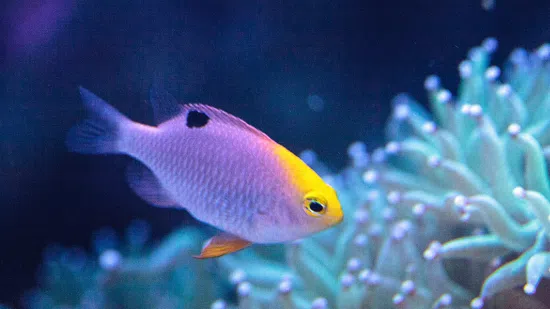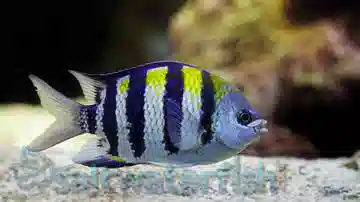Johnston Damsel
Plectroglyphidodon johnstonianus
(0 Reviews)

Johnston Damsel
Plectroglyphidodon johnstonianus
(0 Reviews)
{{ item.name }}
Size: {{ item.extra_field_3 }}
${{ getFormattedPrice(item.saleprice) }} ${{ getFormattedPrice(item.price) }}
To join the waiting list, click here
Free Shipping
With
$199.00
or more in Marine Life.
More details...
Johnston Damsel Care Facts
| Care Level: | Easy |
|---|---|
| Temperament: | Smi-Aggressive |
| Diet: | Omnivore |
| Origin: | Indo-Pacific Ocean |
| Acclimation Time: | 1+ hour |
| Reef Safe: | Monitor |
| Minimum Tank Size: | 50 gallons |
| Max Size: | 6 inches |
The Johnston Damselfish (Plectroglyphidodon johnstonianus) thrive in Acropora reefs in the Indo-Pacific. Their body is golden-brown, with blue eye lids and a large black stripe just before the caudal fin. They feed on crustaceans, algae, and occasionally polyps of SPS corals, so it is recommended they are kept in a system without SPS coral. Reaching a maximum size of nearly 6 inches, they should not be kept in a system smaller than 50 gallons, and should be fed a well mixed diet of crustaceans and algae. The Johnston Damsel, like many other Damselfish, may be aggressive or territorial towards other fish in the aquarium, especially if they are spawning.
Johnston Damsel Overview
The Johnston Damsel (Plectroglyphidodon johnstonianus) stands as a captivating addition to saltwater marine aquariums, offering enthusiasts a glimpse into the fascinating world of marine life. This resilient species, hailing from the tropical waters of the Indo-Pacific region, has become a sought-after choice among hobbyists due to its striking appearance and ease of care.
Habitat of the Johnston Damsel
In the wild, Johnston Damsels are commonly found in coral-rich areas, hovering over the coral heads and rocky substrates. Their natural habitat is characterized by warm temperatures and abundant coral formations, providing ample hiding spots and territories for these small but vibrant fish.
Reef Compatibility of the Johnston Damsel
Known for their peaceful nature, Johnston Damsels are considered reef-safe. They exhibit minimal interest in coral polyps and tend to coexist harmoniously with various coral species, making them suitable for reef aquariums.
Size and Lifespan of the Johnston Damsel
The Johnston Damsel typically reaches a maximum size of around 4 inches (10 cm) in captivity. They can live up to 5 to 7 years with proper care, making them a long-term commitment for marine enthusiasts.
Diet of the Johnston Damsel in Captivity
Feeding these damsels is a straightforward affair. They accept a varied diet that includes high-quality marine pellets, frozen or live brine shrimp, and other small meaty foods. Ensuring a balanced and nutritious diet contributes to their vibrant coloration and overall well-being.
Aquaculture and Availability of the Johnston Damsel
Johnston Damsels are not extensively aquacultured, but they are readily available to hobbyists from reputable suppliers like Saltwaterfish.com. The availability of captive-bred specimens reduces the impact on wild populations and ensures a sustainable source for aquarium enthusiasts.
Compatibility with Other Fish and Invertebrates
While generally peaceful, it's essential to consider tankmates carefully. Johnston Damsels may become territorial, especially during breeding, so introducing them to compatible tankmates is crucial. Avoid aggressive or larger species that might disrupt the delicate balance in the aquarium.
Sexual Dimorphism of the Johnston Damsel
Sexual dimorphism in Johnston Damsels is minimal, with both males and females sharing similar appearances. Distinguishing between the sexes is challenging, making it advisable to maintain them in small groups to encourage natural pairing.
Juvenile to Adult Coloration Changes in the Johnston Damsel
Juvenile Johnston Damsels boast a vibrant blue and yellow coloration, gradually transitioning to a more subdued blue and black pattern as they mature. This color evolution adds a dynamic visual element to the aquarium, captivating observers as they observe the transformation.
Temperament of the Johnston Damsel
Known for their peaceful demeanor, Johnston Damsels are an excellent choice for community tanks. However, occasional territorial behavior may surface, particularly during breeding periods. Adequate hiding spots and proper spacing help mitigate potential conflicts.
Tank Requirements for the Johnston Damsel
Maintaining a suitable environment is crucial for the well-being of Johnston Damsels. A minimum aquarium size of 30 gallons is recommended, providing ample swimming space and territory. Adequate live rock formations offer hiding spots and mimic their natural habitat.
Water Conditions for the Johnston Damsel
- pH: 8.1 to 8.4
- Salinity: 1.020 to 1.025
- Temperature: 74°F to 82°F
- Water Flow: Moderate to high
Other Common Names of the Johnston Damsel
Johnston's Damsel
Blue Devil Damselfish
Yellowbelly Damsel
Five Compatible Tank Mates for the Johnston Damsel
- Royal Gramma (Gramma loreto)
- Clownfish (Amphiprion spp.)
- Firefish Goby (Nemateleotris spp.)
- Banggai Cardinalfish (Pterapogon kauderni)
- Coral Beauty Angelfish (Centropyge bispinosa)
Why Choose Johnston Damsel from Saltwaterfish.com
Saltwaterfish.com is a reputable supplier committed to delivering healthy and responsibly sourced marine life. Their stringent quarantine and acclimatization processes ensure customers receive vibrant and disease-free Johnston Damsels, backed by excellent customer support.
The Johnston Damsel represents a captivating and manageable addition to saltwater aquariums, offering beauty and ease of care. Whether you are a seasoned hobbyist or a beginner, the allure of these damsels, combined with proper husbandry, creates an engaging marine environment for enthusiasts to enjoy.
Currently Johnston Damsel does not have any reviews.















